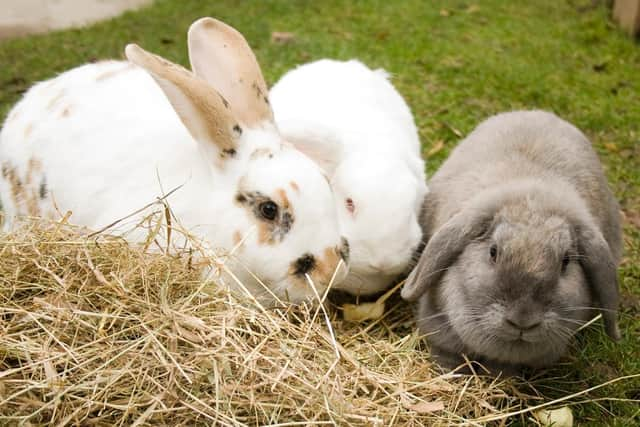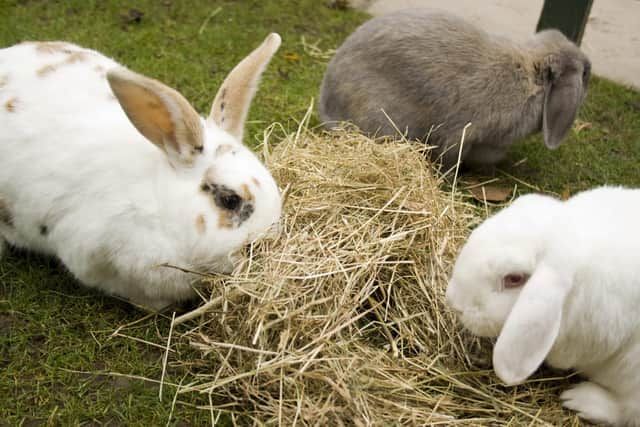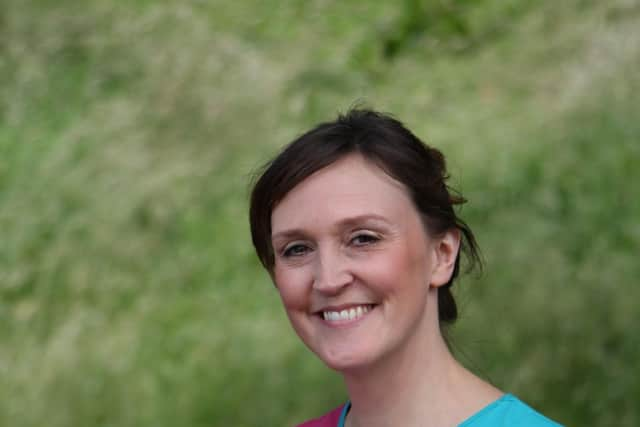PDSA pet advice - Rabbit dental care – how to look after bunny teeth
This article contains affiliate links. We may earn a small commission on items purchased through this article, but that does not affect our editorial judgement.


PDSA vet nurse Nina Downing said good dental care is essential for all pets but rabbits need special attention when it comes to caring for their teeth.
“Our bouncing bunnies can be prone to painful dental issues, sadly made worse in many cases by selective breeding and not feeding enough hay. Rabbits need hay – it is the most important part of their diet. Not only is it well-balanced and full of fibre, it’s really important for keeping rabbit teeth healthy – a poor diet can contribute to dental disease in bunnies.
Advertisement
Hide AdAdvertisement
Hide Ad“Unlike human teeth, theirs grow constantly throughout their life, so they need to spend a lot of time nibbling and chewing to wear them down. If your rabbits’ teeth don’t get constant wear through grazing, they’ll start to overgrow.


“So it’s vital you keep your rabbit supplied with plenty of good quality feeding hay. We’re working with Burgess Pet Care to promote the welfare needs of rabbits and small animals, and recommend feeding Burgess Excel Feeding Hay with Dandelion and Marigold, while also allowing them to graze on growing grass in their run.
“You can also give them fresh vegetables such as cabbage, broccoli and bell peppers, along with just one tablespoon of rabbit nuggets per day, two if they’re a large breed.”
It’s not always easy to examine your rabbits’ mouths – in most cases, we can only see front teeth. If they are overgrown or growing in a strange direction, it’s likely that the teeth further back are also growing oddly and will be causing problems and pain. Have your rabbits’ teeth routinely checked by your vet a few times a year.
Advertisement
Hide AdAdvertisement
Hide Ad“Rabbits instinctively hide pain and discomfort, so unfortunately dental disease can often go unnoticed for a long time. Early warning signs that your bunny may be suffering include dropping food while they’re eating, drooling or being wet around the mouth.


“You may also notice weight loss, teeth grinding, a bumpy jawline, reduced appetite, diarrhoea, a change in behaviour or a build-up of caecotrophs (sticky poos) around their bottom.
“Rabbits that have been bred to have a flatter face shape with a shorter nose and jaw have less space in the mouth, so the teeth become misaligned, preventing them from being worn down when chewing.”
PDSA is the UK’s largest vet charity helping pets across UK whose owners struggle to afford treatment costs. Support from players of People’s Postcode Lottery helps us reach even more pet owners with vital advice and information. Visit www.pdsa.org.uk website. (photos: Quench Studios)
ASK OUR EXPERT


PDSA Vet Nurse Nina Downing answers all your pet questions
Advertisement
Hide AdAdvertisement
Hide AdDear PDSA Vet, my dog had five puppies about a week ago but one of them is much smaller than the others. He keeps getting pushed out of the way and I’m not sure if he’s getting enough to eat. Should I do anything to intervene? Elsa
Dear Elsa, the first thing to do is to weigh the puppies each day to make sure they’re gaining weight. If the puppy isn’t gaining weight as he’s being pushed out, you may need to move the other pups to one side so he can feed first.
But, if he’s too weak to do this, you may need to hand rear him – speak with your vet for advice on bottle feeding. Hand rearing puppies is a big commitment. In the first couple of weeks of life, pups need to feed every two to three hours.
Dear PDSA Vet, I have just brought home my first hamster. Every time I try to get her out of her cage, she goes back down her tunnel or runs away from me as fast as she can. Why is she doing this and is there anything that can prevent her from running away? Michael
Advertisement
Hide AdAdvertisement
Hide AdDear Michael, your hamster needs time to settle into her new home and get used to you – running away is an instinctive behaviour that helps to keep hamsters safe in the wild.
Approach her calmly and gently, never from above, and avoid waking her up during the day as hamsters are nocturnal.
Offer her favourite food from your hand so that she learns to associate you with something nice.
Then, when she seems happy to approach you, try gently scooping her up from beneath her in your open palms, remembering to always hold her near a surface in case she falls.
Advertisement
Hide AdAdvertisement
Hide AdDear PDSA Vet, My big grey cat Pascal is ten and he’s always been quite heavy, which I think is due to his breed. But recently he seems to have lost a lot of weight – is there something wrong with him? Callie
Dear Callie, there are a number of medical conditions that could be causing your precious puss to lose weight despite a healthy appetite so you should take him to a vet to find out what is wrong.
Certain diseases, such as diabetes, kidney disease and hyperthyroidism can cause weight loss, and may be accompanied by other symptoms such as increased appetite or thirst, or increased need to urinate.
Many of these health problems can be improved with the right treatment, so I’d always recommend visiting your vet to identify the root cause and discuss how you can help your furry friend feel better.
Advertisement
Hide AdAdvertisement
Hide AdPDSA is the UK’s largest vet charity and is supported by the People’s Postcode Lottery. For vital advice and information visit the www.pdsa.org.uk website.
Dear PDSA Vet, My five-year-old dog has recently developed a lump on her face, but it doesn’t seem to cause her any pain. What should I do? Layla
Dear Layla,
Even if she doesn’t appear to be in any pain or discomfort, it’s a good idea to take your pooch to the vet to have the lump checked. They can give her a full examination to determine whether the swelling is a cause for concern – it could be anything from a skin tag, wart, cyst, or the development of an abscess. It may be that your vet concludes that the lump is nothing to worry about, but it’s best to be on the safe side. It’s always a good idea to keep a log of any changes you notice in the lump, you can even track it over time by taking regular photos. For more information about lumps on dogs, visit www.pdsa.org.uk/lumps
.PDSA is the UK’s largest vet charity, on a mission to improve pet wellbeing through prevention, education and treatment. Support from players of People’s Postcode Lottery helps us reach even more pet owners with vital advice and information.
www.pdsa.org.uk website.
For articles you may have missed visit:
Advertisement
Hide AdAdvertisement
Hide Ad